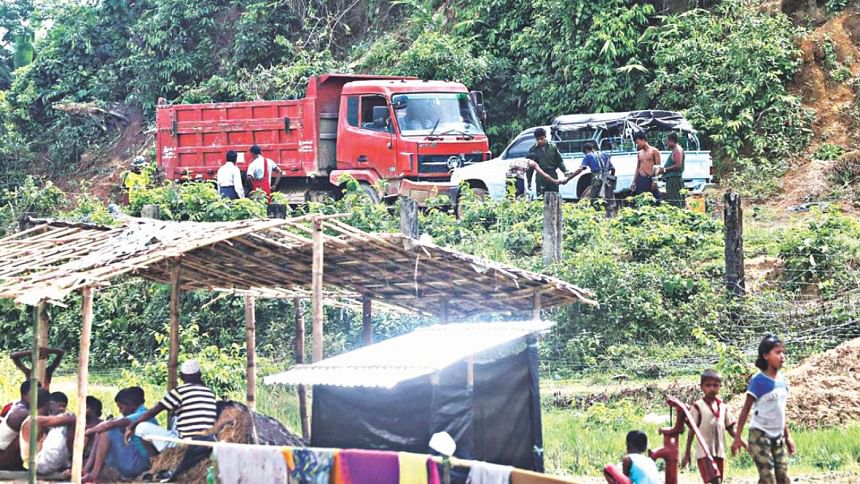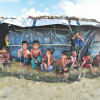6,300 in no-man's land for 45 days

Some 6,300 Rohingya people, mostly women and children, have been stuck in no-man's land along the Naikhyangchhari border since August 27.
Crossing the Myanmar border, the refugees from 1,370 families of 15 villages in Rakhine State's Maungdaw have built makeshift shelters by the Tambru canal near Tambru Bazar in Ghumdhum.
Visiting the area around yesterday afternoon, these correspondents saw Myanmar men in uniform and civilian clothes patrolling with firearms on their side of the border.
Some were digging the ground. They are “security personnel laying land mines”, according to the Rohingyas.
The movement of Myanmar army and Border Guard Police (BGP) near the border is so frequent that one can see them standing just for an hour on the Bangladesh side.
Some Rohingya community leaders are not yet willing to leave the place. Taking a “wait and see” approach, they stay in touch with people on the other side of the border for updates on their properties.
Others, however, want to go to Balukhali in Ukhia, where most of the Myanmarese citizens arriving since late August are staying in makeshift camps.
There is no coordination committee for the refugees in the no-man's land. Officials of Border Guard Bangladesh (BGB) provide them with medicine and relief materials regularly.
A few are allowed to cross the knee-deep canal to go to Tambru Bazar to buy supplies, when needed. They have to return after the shopping.
Asked about the stranded Rohingyas, Monzurul Hassan Khan, director of Cox's Bazar BGB Battalion-34, said, “We are yet to get any directives about them.”
Kabir Ahmed, who is from Panirchara area of Maungdaw, said, “We came not to stay here forever. We will return to our country if the Myanmar government gives us citizenship status.”
LAND MINE CURSE
Sabikunnahar, 45, fled Myanmar in early September and lost her two legs while crossing the border.
“She was unaware that mines were planted in the bordering area. She was taken to Chittagong Medical College where she took treatment for around one month. A few days ago she came to this no-man's land,” said Arif Ahmed, who was her neighbour in Myanmar.
Nurul Amin, a farmer who owned around 15 acres of land and a number of shrimp hatcheries in Tombru Right area of Maungdaw, said he along with his five family members arrived on August 27.
“We do not want to stay in no-man's land anymore. We want to go to camps,” he said.
Nurul added, “The Myanmar army has laid mines in the border area. My 10-year-old son Mustakim was badly injured when he crossed the border on September 3. He is yet to recover.”
Human Rights Watch in a report last month said Myanmar forces have laid landmines during attacks on villages and along the Bangladesh border, posing a grave risk to Rohingyas fleeing atrocities.
“The dangers faced by thousands of Rohingyas fleeing atrocities in Burma [Myanmar] are deadly enough without adding landmines to the mix,” said Meenakshi Ganguly, South Asia director, calling upon Myanmar to immediately stop the use of antipersonnel landmines and joining the 1997 Mine Ban Treaty.
Meanwhile, the death toll from Sunday's capsize of an overloaded refugee boat in the Naf River rose to 23 as police in Cox's Bazar said the bodies of another nine Myanmar nationals washed up on the shore.
Among the nine, three were found on Monday night and six early yesterday. More than half of the victims were children, officials said.
Late last month, more than 60 refugees were feared to have died when the boat carrying them from Myanmar sank due to rough weather in the Bay.
Villagers at Shah Porir Dwip, where the boats mostly land, told AFP that the Rohingyas were increasingly travelling at night to avoid strict border patrols in Bangladesh, making the journey even more dangerous.
'NOW JUST BEGGARS'
A number of Rohingyas sheltered in the no-man's land were rich and even owned personal vehicles back in their homeland. Some are well educated, can speak English while some claim to have completed graduation.
Sayeed Alam is one of them. He says he graduated in biochemistry from Sittwe University in Rakhine and completed his education in 2008. Higher education for Muslim students has been completely banned from 2012, he added.
“In Maungdaw, my father and grandfather held the post of village administrator. We were solvent. But now we are just beggars.”
His seven other brothers also studied up to Class X.
“I was a good student and that's why my father spent a huge amount of money on me. I used to teach children in my village,” Sayeed said.
The 30-year-old married Momtaz Hossain just six months ago. “I came here on September 5 with my family members. I do not know what lies ahead. But we want a permanent solution and want to go back to Myanmar.”
Sayeed said he had 20 acres of farmland and a 10-acre garden very close to Bangladesh border. He was in “very good terms” with local authorities of Myanmar.
“When violence erupted, I contacted BGP and local authorities and they assured me that everything will be fine. But I myself witnessed that a house next to mine was set afire,” said Sayeed, who owned two private cars.
“Then I decided to cross the border as I have good Bangladeshi friends. I left everything and started staying in makeshift tents built with polythene sheets and bamboos in this no-man's land.”
The story of Deen Mohammad, another refugee, is quite interesting. He claims to have studied in Yangon University and worked as an interpreter between Bangladesh and Myanmar officials.
“In the last 10 years, I worked as an interpreter during the BGB-BGP flag meetings. But my son had to suffer bullet injuries while army was shooting indiscriminately in my village,” he said.
'FULL ALERT'
More than 5,20,000 Rohingyas have crossed over into Bangladesh since August 25 after insurgent attacks on police posts in Rakhine triggered a brutal military operation.
The rate had slowed to about 2,000 refugees per day last week, but on Monday, an estimated 12,000 of them entered Cox's Bazar as a severe food crisis and violence in Myanmar triggered a fresh exodus.
The UN Refugee Agency puts the figure at 11,000.
"We're back in a situation of full alert as far as influxes are concerned. It is a big increase to see 11,000," UNHCR spokesperson Adrian Edwards said at a news briefing in Geneva yesterday.
“UNHCR is working with the Bangladesh authorities on a transit centre to prepare for a potential refugee influx in the coming days,” he said, adding, “This is in view of Monday's sudden increase in people arriving from Myanmar.”
UNHCR sources say that many of the new refugees came from the Buthidaung area in northern Rakhine. Buthidaung town is some 25 kilometres east of Maungdaw, writes our diplomatic correspondent.
Some said they fled torching and killings back home; a boy was seen with a big gash across his neck. Others said they left in fear ahead of anticipated violence.
To reach Bangladesh, they walked for up to 14 days. Many were carrying children and baskets containing whatever they could pack at short notice. They waded through marshland before swimming across the Naf River that divides the two countries.
Many women and children could not swim and had to ride piggyback on volunteer swimmers. Some used inflated plastic bags and UNHCR tarpaulins as makeshift flotation devices, said the spokesperson.

SINGAPORE'S AID
The Singapore government sent 7.162 metric tons of relief materials for the Rohingyas in Bangladesh yesterday.
A cargo flight from Singapore landed at Chittagong Shah Amanat International Airport with the relief goods in the morning.
Divisional Commissioner of Chittagong Mohammad Abdul Mannan received the relief materials from Singapore's Defence and Foreign Affairs Minister Dr Mohamad Maliki bin Osman.
The items included tents, dynamo lights, blankets, medical supplies, meal packs, solar puffs and collapsible jerry-cans, Habibur Rahman, Additional Deputy Commissioner told BSS.

 For all latest news, follow The Daily Star's Google News channel.
For all latest news, follow The Daily Star's Google News channel. 








Comments